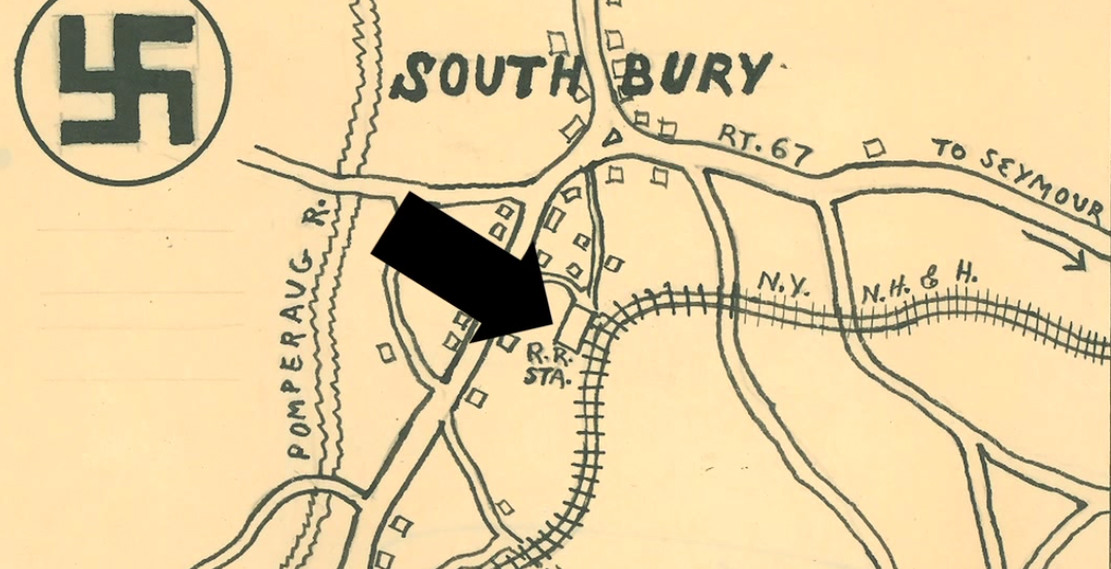When U.S. Nazis got the boot
Little-known 1930s tale comes to Temple Beth El in Cedarhurst
Two longtime friends, members of Lawrence High School’s class of 1966, have partnered to bring a little-known story to the Five Towns that focuses on how a small town in Connecticut forced the German American Bund, an American Nazi organization, to retreat 70 years ago.
Three days after the 76th anniversary of the Japanese attack on Pearl Harbor, which dragged the U.S. into World War II, Temple Beth El, in Cedarhurst, will show the documentary “Home of the Brave: When Southbury Said No to the Nazis” on Sunday at 9:45 a.m. The 40-minute film, made in 2012, includes scenes with Woodmere native Ed Edelson, the first selectman (similar to a mayor) in Southbury, Conn., who will lead a discussion on the documentary. His friend is Bob Fischman, the temple’s president, a Woodmere resident.
In the 1930s, the German American Bund was building Nazi training camps in rural areas across the U.S., and meeting with little resistance. The Bund aligned itself with the beliefs and goals of Germany’s Nazi Party. In 1937, it planned to build the largest camp in the nation in Southbury.
“Six years ago, there was an interfaith Thanksgiving dinner, and I had recently became the first selectman of the town,” Edelson said, “Rabbi Eric Polokoff [of Temple B’nai Israel in Southbury], Rev. Shannon Wall [of the South Britain Congregational Church] and I made a pact that we would make something that the town would respond to and premiere it on the 75th anniversary” of Pearl Harbor.
The three civic leaders approached Southbury resident Scott Sniffen, a filmmaker, who said he had heard of the story, but wasn’t familiar with all the facts. “My wife said to do this, it’s cool,” Sniffen said. “I’ve done many projects, but this kind of thing is more rewarding, because of the way it moves people. It was real.”
According to Edelson, the story had been forgotten until 1991, when a Southbury town clerk was doing research and found the zoning regulations from 1937. Then a reporter for the local newspaper, the Republic American, wrote an article recounting the story. Polokoff had also put together a presentation, but said it needed a “proper documentary,” Edelson said.
In late 1937, when Southbury residents learned of the 187-acre land purchase and what was going to be built, they formed a zoning committee and passed two resolutions opposing the Bund camp. The Rev. M. Edgar Lindsay, spiritual leader of the South Britain Congregational Church, led the pushback, which became national news, according to Arnie Bernstein in his 2013 book “Swastika Nation: Fritz Kuhn and the Rise and Fall of the German-American Bund.”
Bernstein recounted how the town stood up to the Bund and forced it to literally “get out of town.” “This is just a ‘sleepy little country town’ as the reporters characterized,” the Southbury Town Report of 1937 stated, “but it seems we know when to wake up.”
Months earlier, U.S. Attorney General Homer Cummings had begun a federal investigation of the plan to build the camp. A 14-volume report, “Nazi Camps in the United States,” was released on Jan. 5, 1938. Cummings’s conclusion: The German American Bund was guilty of producing unpopular speech.
Fischman said he believed the Southbury story has relevance today. “It’s an interesting story for general viewing,” he said. “However, when you reflect on the Charlottesville incident, the growth of the alternative right in the U.S., the nationalistic party growth in countries like France, Italy and Germany and the increases reported in anti-Semitism on campuses and throughout the world, the efforts of the Southbury community in 1937 should inspire and motivate us to do whatever is necessary to counteract these movements today.
Edelson said that he contacted the United States Holocaust Museum in Washington, D.C., and officials there had never heard the story. In April, the museum will open a new exhibit, focusing on similar incidents in the U.S., and it will include Reverend Lindsay’s typewriter and many of the letters he wrote at the time, which his family donated.
The film has been shown nearly 100 times to various organizations, Edelson said, and is being used in some schools as part of their curriculum. “Historically, we thought it was important,” he said. “It brought up very interesting, complex questions. It’s technically legal to build a building, but [that Southbury residents] clearly [understood] it was going to be used for something abhorrent raises the question, what would you do?”
Temple Beth El is at 46 Locust Ave. in Cedarhurst. Admission to Sunday’s screening is free, and breakfast will be served.

 39.0°,
Fair
39.0°,
Fair 





